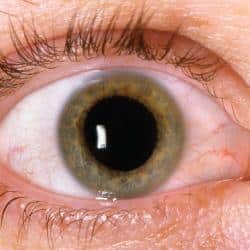
Dry eye causes and risk factors can vary, too. Some suffer from it due to their environment, while some are simply born with structural problems in their eyes.
As dry eye causes vary widely, symptoms and treatment for dry eyes may also differ. Two people with Dry Eye Syndrome may not have the same set of symptoms nor will they experience relief with the same set of treatments.
It’s important to learn different early dry eye symptoms, what can be done for relief, and when to visit the doctor to avoid complications.
Dry Eye Symptoms – Mild, Moderate, Severe
Keep in mind that dry eye symptoms may not appear all at once. They usually occur gradually and if they’re not permanent, they may last from hours to days. The most common symptoms responsible for the pain and discomfort associated with dry eyes are:
Mild symptoms
- Sandy or gritty feeling in the eye as the day progresses
- Feeling of something foreign in the eye
- Stinging or burning sensation
- Redness and swelling
- Excessive blinking
- Uncomfortable contact lenses
Moderate symptoms
- Eye pain
- Excessive tearing
- Eye fatigue
- Eyelid twitching
- Heavy eyelids
Severe symptoms
- Inability to cry
- Episodes of vision fluctuation
- Incapacitated difficulty reading, working in front of the screen, or any activity that calls for sustained visual attention
Untreated dry eye can damage the cornea (keratitis) and cause permanent scarring. Scarred corneas are more vulnerable to infection and ulceration, which in turn increases the risk of vision loss.
Who Is Likely to Develop Dry Eye Symptoms?
The elderly are more likely to develop dry eyes as part of the natural process of aging. Eye structures may not function at their best.
Prescription medications for common conditions affecting the elderly such as hypertension and Parkinson’s Disease can induce dry eye symptoms.
Women are also more prone to developing Dry Eye Syndrome because of hormonal imbalances from an underlying condition, menopause, or regular use of birth control pills.
What Can I Do For Dry Eye Relief?
When treating dry eyes, it’s best to treat or manage the underlying cause. For instance, if the symptoms are a result of your constant exposure to irritants, reduce or eliminate your exposure to these irritants.
While you’re still figuring out the underlying cause of your mild dry eye symptoms, the following measures can offer relief.
- Use lubricating eye drops and/or artificial tears. Artificial tears and other over-the-counter eye drops for dry eyes are available in varying viscosity and with different ingredients, depending on what’s missing from your tears.
- Apply warm, moist compresses to the eye area twice daily to open blocked glands. This will promote the release of natural oils into the tear film and eventually encourage lubrication.
- Avoid dry, arid climates when you can. Wear sunglasses with wrap-around frames if you can’t avoid drying winds. This will help slow down tear evaporation.
- Blink often and take breaks in between work that requires a sustained vision for long hours.
- Put your humidifier to good use during winter as it helps moisten the air. Winters are dryer than summers.
- Reduce the number of hours you wear your contact lenses.
- Switch to another medication if your dry eye symptoms are proven to be a side effect of your existing prescription drugs.
When to Get Help for Dry Eye
Schedule an appointment with your eye doctor or general physician if you experience any of the aforementioned moderate or severe symptoms.
A general doctor can check if the problem is caused by an underlying condition. If it has something to do with structural or functional eye problems, your doctor will refer you to an eye specialist.
Recommended Treatments for Dry Eye Syndrome
Next to eye drops and lubricants, moderate to severe dry eye symptoms can be managed and treated with the following:
- Silicone or acrylic punctal plugs can be plugged into tiny, circular holes in your upper and lower eyelids through a simple procedure. This will help keep the tears from evaporating.
- Intense Pulsed Light (IPL) treatment is growing in popularity. When eye drops, warm compresses, and other treatments don’t do the trick, IPLis a modern solution for those suffering from chronic dry eyes. Using quick bursts of light on the lower eyelids and upper cheek areas, IPLheats up the eyelid glands that might be blocked with stagnant secretions. Although many patients notice improvement after a single treatment, monthly (or maintenance) treatments are sometimes necessary.
- Medications such as anti-inflammatory drops, gelling agents, oil-based drops, steroid eye drops, serum eye drops, and bicarbonate drops may be prescribed by your eye doctor. These medications can either reduce inflammation (if it’s the underlying cause) or encourage tear production.
If you believe you currently suffer from any of the dry eye symptoms mentioned here, take the next step. Why not schedule a consultation with one of our dry eye specialists today? We have 15 clinic locations in Phoenix, Tucson, and northern Arizona.
For more information about dry eyes and the treatments, download our dry eye guide eBook.

